Amphibians ID Guide: Salamanders
Indiana is home to 23 species of salamanders. Many may look similar in
appearance while others may look nothing like a salamander.
This guide should help you with identification. It includes photos,
range maps, and descriptions. You may also check out
INherpatlas.org.
Amphibians need our help now more than ever, as they are most susceptible to pollution and
other environmental challenges. Besides the HHS, there are other organizations dedicated to
the conservation of amphibians. INaturalist.org and
Herpmapper.com are citizen science
friendly herp data collection sites.
FrogwatchUSA is based specifically on amphibians.
Photos and videos courtesy of Jim Horton and Andrew Hoffman.
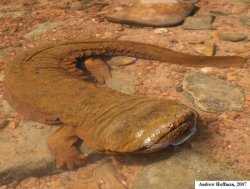 |
Hellbender
Cryptobranchus a.alleganiensis
Size: 11 – 25 inches
Species Status: Endangered
Similar Species: Mudpuppy
more >> |
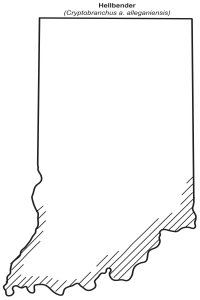 |
Hellbender
Cryptobranchus a.alleganiensis
Size: 11 – 25 inches
Species Status: Endangered
Description: Large aquatic salamander. Typically brown to grayish but also
olive to dark brown with flat, wide head and tiny eyes. May have dark blotches
and flecks on back. Wrinkled, fleshy folds of skin run from head, along sides
to base of tail.
Habitat: Found in clean, cool, well aerated rivers and streams with ample
rock cover
Habits: Spends much of its time beneath large flat rocks. Active at night
and overcast days.
Diet: Mostly crayfish but will consume earthworms, fish, and invertebrates
Reproduction: Males build nests beneath large rocks using small stones.
Females soon deposit long strands of eggs.
Similar Species: Mudpuppy
<< less
|
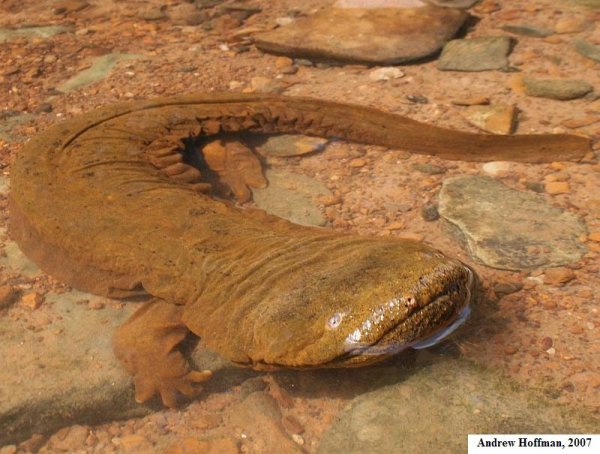 |
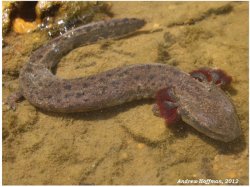 |
Mudpuppy
Necturus maculosus
Size: 8 - 14 inches
Species Status: Unknown to uncommon
Similar Species: Hellbender
more >> |
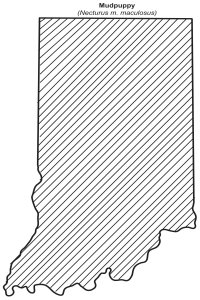 |
Mudpuppy
Necturus maculosus
Size: 8 - 14 inches
Species Status: Unknown to uncommon
Description: Large aquatic salamander with maroon red, feathery external
gills. Dark brown, rust, or grayish with dark spots on body. Dark streak runs
through the eye. Body is round and blunt head. Has four toes on all four feet.
Young have wide light stripes from head to the tail.
Habitat: Found in lakes, ponds, streams and other permanent water sources.
Usually found in deep depths.
Habits: This species retains its gills throughout it life. Spends much of
its time along the bottom of lakes and streams. Mainly nocturnal but may be
active in muddy water during daylight. They feed heavily in winter months.
Diet: Crayfish, mollusks, earthworms, fish, fish eggs, and invertebrates
Reproduction: Mating occurs in autumn and 50-100 eggs are laid in the
following spring
Similar Species: Hellbender
<< less
|
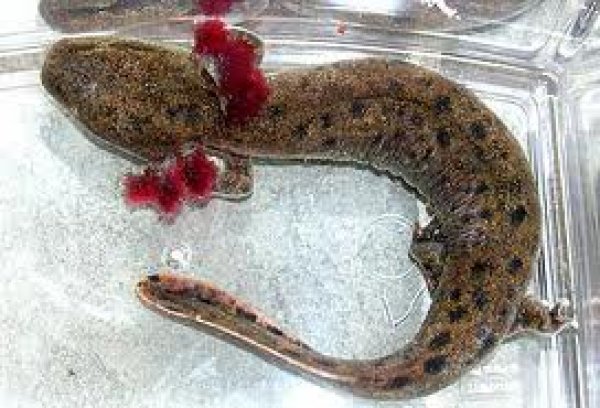 |
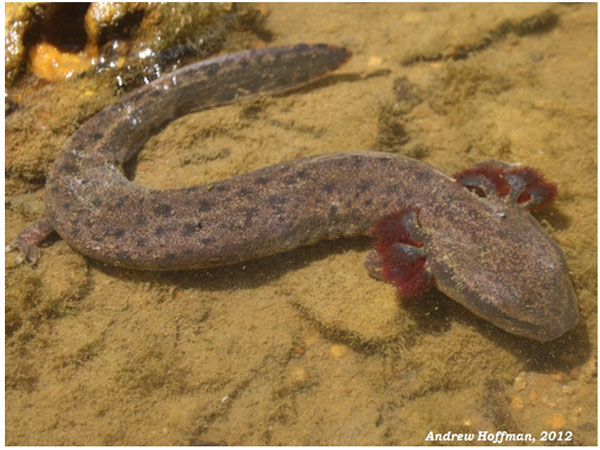 |
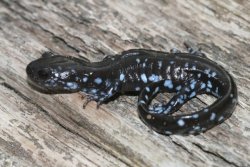 |
Blue Spotted Salamander
Ambystoma laterale
Size: 4 – 5 ½ inches
Species Status: Species of Special Concern
Similar Species: Jefferson salamander and Slimy salamander
more >> |
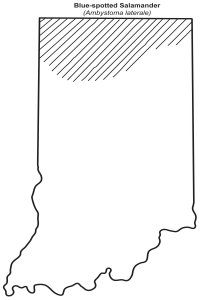 |
Blue Spotted Salamander
Ambystoma laterale
Size: 4 – 5 ½ inches
Species Status: Species of Special Concern
Range: More common in the upper northwest counties but range is throughout
the north
Description: Dark gray to black background with light blue speckling
throughout. Similar to the Jefferson’s salamander but limbs toes are shorter
and speckled. 12 - 13 costal grooves on sides. Belly dark brown to slate and
speckled. Tail is laterally flattened.
Habitat: Woodland hardwood forests with temporary or permanent wetlands
or ponds
Habits: Inhabits moist woodlands with sandy soil. Found in or beneath
rotting logs, moss, leaf litter, or stones.
Diet: Earthworms and other invertebrates
Reproduction: Mating occurs in early spring when rain and temperatures
reach 55 degrees. Breeding may take place in woodland ponds or ditches.
Similar Species: Jefferson salamander and Slimy salamander
<< less
|
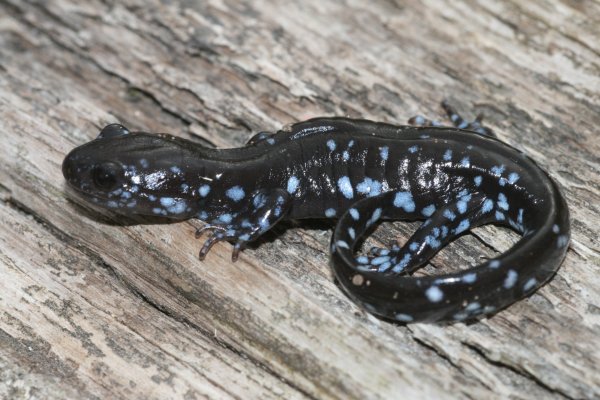 |
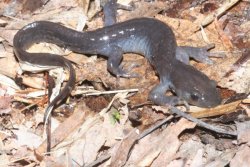 |
Jefferson Salamander
Ambystoma jeffersonianum
Size: 6 - 8 inches
Species Status: Common but not commonly encountered
Similar Species: Smallmouth salamanders
more >> |
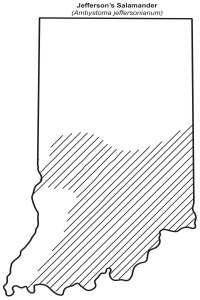 |
Jefferson Salamander
Ambystoma jeffersonianum
Size: 6 - 8 inches
Species Status: Common but not commonly encountered
Range: Found in most of the southern half of the state but absent in the
lower Wabash Valley of southwest Indiana
Description: A medium size grayish blue or brownish salamander with long
limbs, toes, and tail. Body somewhat slender with 12-14 costal grooves.
Habitat: Inhabits hardwood forests
Habits: A burrowing species that may be found in rotting logs and leaf
litter
Diet: Earthworms and other invertebrates
Reproduction: One of the earliest breeders. Active as early as January but
typically in February when rains and temps reach 55 degrees. Female deposits
eggs in tall globular masses onto plant stems and sticks beneath the water.
Larvae have external gills.
Similar Species: Smallmouth salamanders
<< less
|
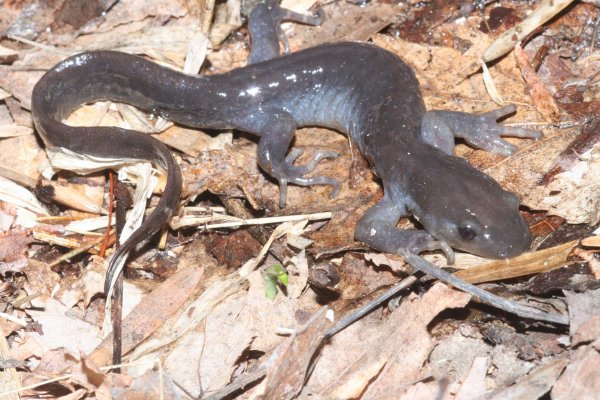 |
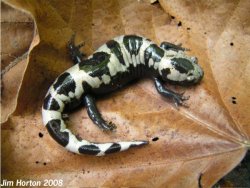 |
Marbled Salamander
Ambystoma opacum
Size: 3 ½ – 4 inches
Species Status: Common in its range
Similar Species: None
more >> |
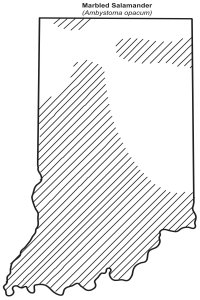 |
Marbled Salamander
Ambystoma opacum
Size: 3 ½ – 4 inches
Species Status: Common in its range
Range: More common in south to central Indiana but a population exists in
the Dunes region along Lake Michigan and an isolated population in southeast
counties.
Description: A stocky black salamander witih grey to white crossbands.
Dark gray to black background with wide, grey or white bands across back from
head to tail. Limbs are dark and mottled or lightly speckled. 11 - 12 costal
grooves on sides. Belly is dark slate or black. Tail is round and ends at a
pointed tip.
Habitat: Hardwood forested uplands and floodplains with temporary or
permanent wetlands or ponds
Habits: Inhabits moist woodlands with loose soil. This species is known to
burrow and utilize rodent burrows. Found in or beneath rotting logs, leaf
litter, or large stones.
Diet: Earthworms, slugs, snails, and other invertebrates
Reproduction: Mating occurs in autumn (unlike most of our other
salamanders) Heavy fall rains trigger breeding activity. Mating takes place on
land near woodland ponds or ditches. Females lay 75-200 round, silvery eggs
(not in a jelly like mass). Females dig a depression close to a water source
under fallen logs or rocks and stays curled with eggs. Females await heavy
rainfall that washes eggs into the water and young soon develop.
Similar Species: None
<< less
|
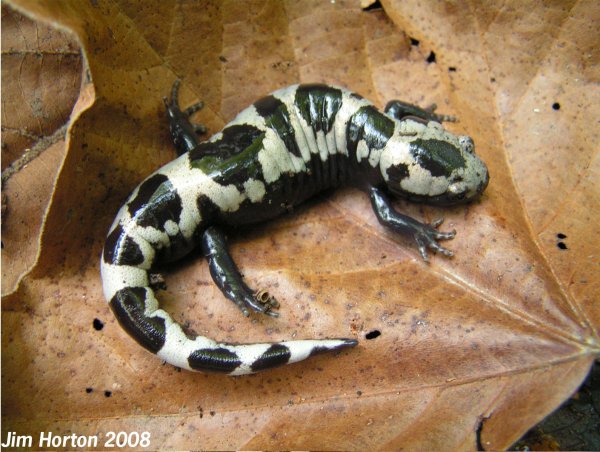 |
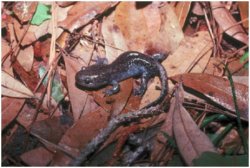 |
Mole Salamander
Ambystoma talpoideum
Size: 3 – 3 ½ inches
Species Status: Endangered
Similar Species: Jefferson salamander (longer and slim body)
more >> |
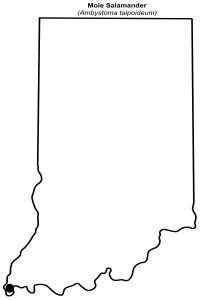 |
Mole Salamander
Ambystoma talpoideum
Size: 3 – 3 ½ inches
Species Status: Endangered
Range: Restricted to the lowlands of Posey County.
Description: A stout bodied chubby salamander with large, wide, rounded
head and short, compressed tail. Body is dark grey, brown, to black with flecks
of bluish white throughout. Large limbs are speckled and tail is laterally
flattened. Costal grooves present on sides.
Habitat: A burrowing species inhabiting lowland forest, valleys, and
floodplains with temporary or permanent wetlands.
Habits: Inhabits moist woodlands. Found in or beneath rotting logs or
leaf litter.
Diet: Earthworms and other invertebrates.
Reproduction: Mating occurs from December through late February when rain
and temperatures reach 55 degrees. Breeding may take place in woodland ponds or
ditches.
Similar Species: Jefferson salamander (longer and slim body)
<< less
|
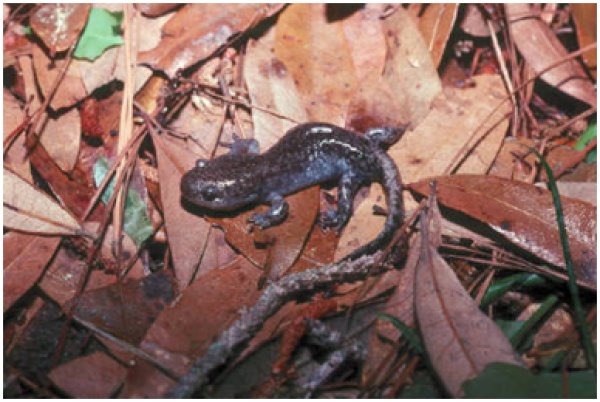 |
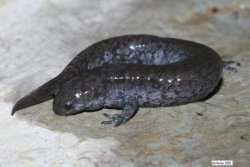 |
Smallmouth Salamander
Ambystoma texanum
Size: 4 – 5 ½ inches
Species Status: Common
Similar Species: Jefferson salamander and Streamside salamander
more >> |
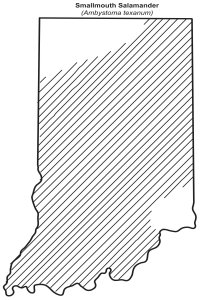 |
Smallmouth Salamander
Ambystoma texanum
Size: 4 – 5 ½ inches
Species Status: Common
Range: Almost state-wide but absent from northern lake region and extreme
southeast
Description: Dark gray or bluish to black with small head and mouth and
short limbs. 13 – 15 costal grooves on sides. Lichen like markings on sides and
tail of some specimens. Others are almost all grey or black.
Habitat: nhabits woodland areas near river bottoms, swamps, and other
lowland areas near water sources
Habits: A fossorial species that burrows in loose soil and leaflitter.
Found in or beneath rotting logs or stones.
Diet: Earthworms and other invertebrates
Reproduction: Mating occurs in early spring when rain and temperatures
reach 55 degrees. Breeding may occur January through early April. Mating takes
place in shallow wetlands. 3 – 30 eggs are laid in a jellylike mass are deposited
to twigs beneath the water. Larvae have external gills.
Similar Species: Jefferson salamander and Streamside salamander
<< less
|
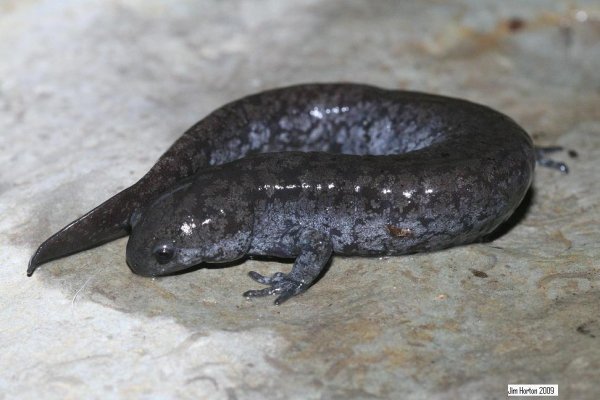 |
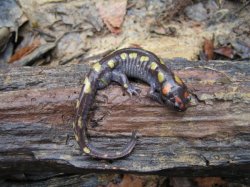 |
Spotted Salamander
Ambystoma maculatum
Size: 4 3/8 - 7 inches
Species Status: Common but not commonly encountered
Similar Species: Tiger salamander. Tigers have pattern on the belly.
more >> |
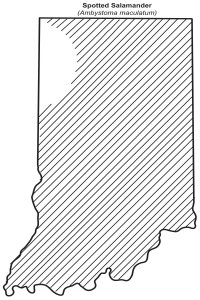 |
Spotted Salamander
Ambystoma maculatum
Size: 4 3/8 - 7 inches
Species Status: Common but not commonly encountered
Range: Found almost state-wide but absent in the sand prairies of
northwest Indiana
Description: Terrestrial salamander with 11-12 costal grooves on sides.
Black background usually with two rows of yellow spots on back. Spots on head
are often orange. Sides are grey to light grey with light speckling. Belly is
gray. Legs have one or two yellow spots and speckling.
Habitat: Inhabits woodlands
Habits: A burrowing species that sometimes lives in burrows of other small
animals. Found in rotting logs and leaf litter.
Diet: Earthworms and other invertebrates
Reproduction: Mating occurs in early spring when rain and temperatures
reach 55 degrees. 50-100 eggs are laid in a globular mass are deposited to
vegetation. Larvae have external gills.
Similar Species: Tiger salamander. Tigers have pattern on the belly.
<< less
|
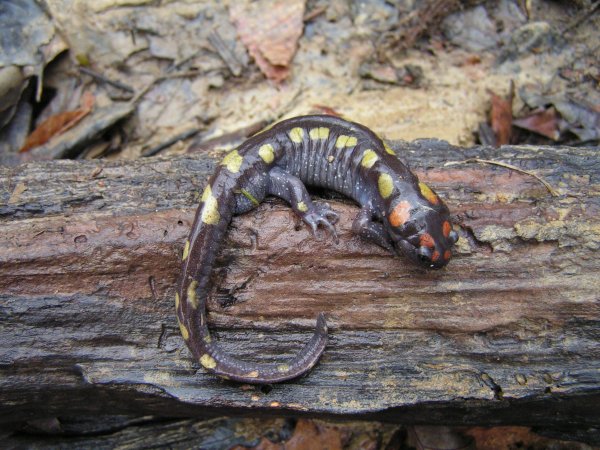 |
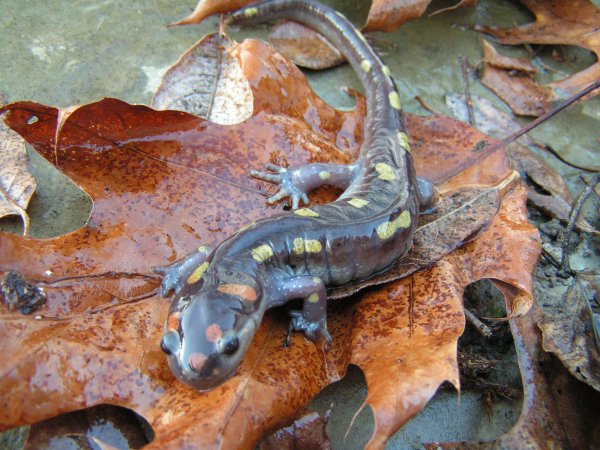 |
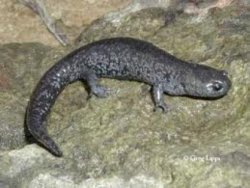 |
Streamside Salamander
Ambystoma barbouri
Size: 4 – 5 ½ inches
Species Status: Species of Special Concern
Similar Species: Jefferson salamander and Smallmouth salamander
more >> |
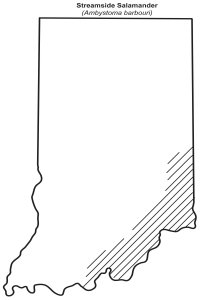 |
Streamside Salamander
Ambystoma barbouri
Size: 4 – 5 ½ inches
Species Status: Species of Special Concern
Range: Restricted to the southeastern Indiana counties along the
Kentucky/Ohio border
Description: Almost identical to the smallmouth salamander. Dark gray or
bluish to black with a small head, mouth and short limbs. 13 – 15 costal grooves
on sides. Lichen like markings on sides and tail of some specimens. Others are
almost all dark grey or black.
Habitat: A species of hilly uplands with small rocky creeks
Habits: May be found beneath stones near or in creeks during breeding
season. They burrow into upland hillsides during the reminder of the year.
Diet: Earthworms and other invertebrates
Reproduction: This species is unique in its breeding habits. It's the only
Ambystoma species that breeds in rocky streams as opposed to ponds. Mating
occurs in early spring when rain and temperatures reach 55 degrees. Breeding
may occur December through March. Mating takes place in rocky streams. Up to
300 eggs in a jellylike flat mass are deposited beneath flat stones in the
water. Larvae have external gills.
Similar Species: Jefferson salamander and Smallmouth salamander
<< less
|
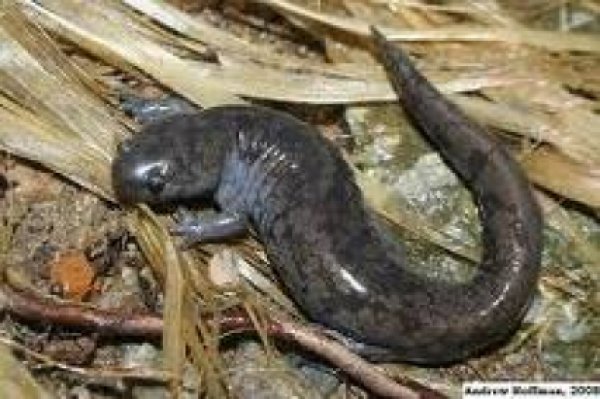 |
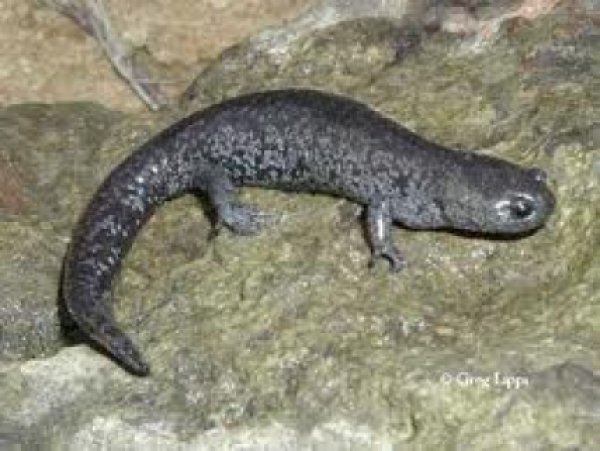 |
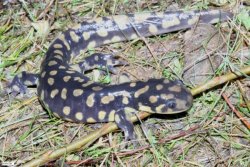 |
Tiger Salamander
Ambystoma t. tigrinum
Size: 7 – 9 inches
Species Status: Common but not commonly encountered
Similar Species: Spotted salamanders. Spotted salamanders have smaller
heads and grey belly.
more >> |
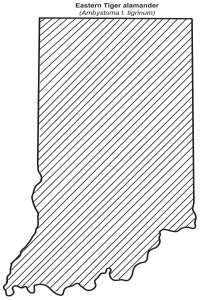 |
Tiger Salamander
Ambystoma t. tigrinum
Size: 7 – 9 inches
Species Status: Common but not commonly encountered
Range: Found state-wide but uncommon in the hill region
Description: Large terrestrial salamander with large, wide head and small
eyes. Tail is long and laterally compressed. 12-13 costal grooves on sides. Dark
brown to black background with yellow, crème, or tan blotches. Blotches are
highly irregular throughout body. Pattern and color is highly variable.
Habitat: Found in meadows and prairies, usually near swamps, marshes, or
other water sources. Often found in basements and window wells of homes.
Habits: A heavy burrower. Sometimes lives in burrows of other small animals.
Diet: Frogs, earthworms, young snakes, and invertebrates. Will consume
anything it can overpower.
Reproduction: Mating occurs in early spring from late February to April.
10-50 eggs in a globular, cylindrical mass are deposited to vegetation. Larvae
are large with external gills.
Similar Species: Spotted salamanders. Spotted salamanders have smaller
heads and grey belly.
<< less
|
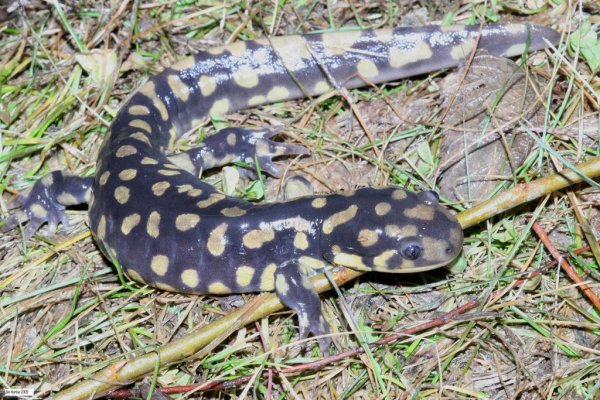 |
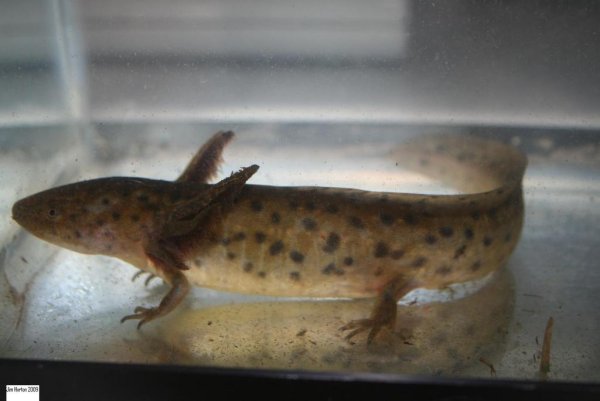 |
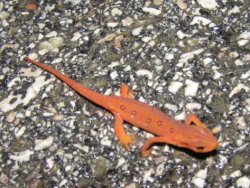 |
Red-spotted Newt
Notophthalmus v. viridescens
Size: 3 – 4 inches
Species Status: Common
Similar Species: None
more >> |
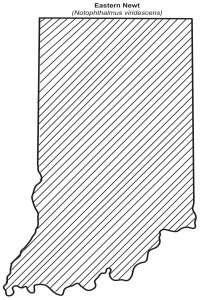 |
Red-spotted Newt
Notophthalmus v. viridescens
Size: 3 – 4 inches
Species Status: Common
Range: Common throughout the state. Indiana has both the red-spotted and
central newts. The two species may intergrade.
Description: A small salamander unlike our other species. This species has
both an aquatic and terrestrial stage. Adults are aquatic. Newts lack costal
grooves and have rough skin. Body is olive to brown or tan with a row of red
spots circled with black ring along the sides. Two longitudinal cranial ridges
occur on top of the head. Tail is vertically flat. Males will have dorsal fins
on the tail. At the red eft stage, the skin is rough and dry. The tail is almost
round. Color is bright red to rust orange. Red spots remain along sides.
Habitat: Woodland forests of both high and lowlands with temporary or
permanent or ponds or other wetlands
Habits: This species goes through four life stages (unlike other
salamanders), egg, aquatic larvae, terrestrial red eft, and aquatic adult. Larvae
transform into efts, which remain on land for 1 – 3 years. They will then return
to water and change into aquatic adults. Efts may be found traversing the
forest floor on rainy days or nights. Aquatic newts may remain active year round.
Diet: Earthworms, crustaceans, young amphibians, and insects. Aquatic
newts consume amphibian eggs.
Reproduction: During mating season, males develop a swollen glands, thick
back legs with thick, black ridges on the inside of the back legs. Aquatic adults
have lungs and lack gills.
Similar Species: None
<< less
|
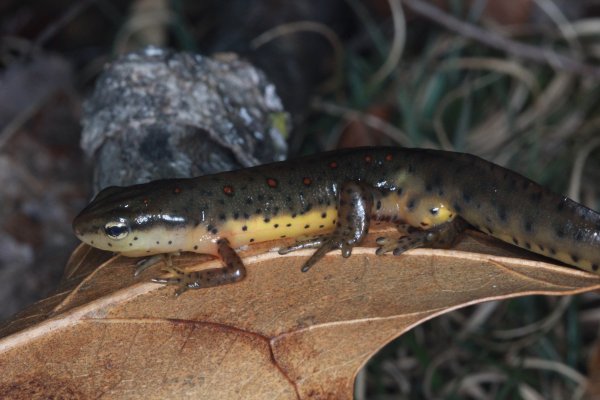 |
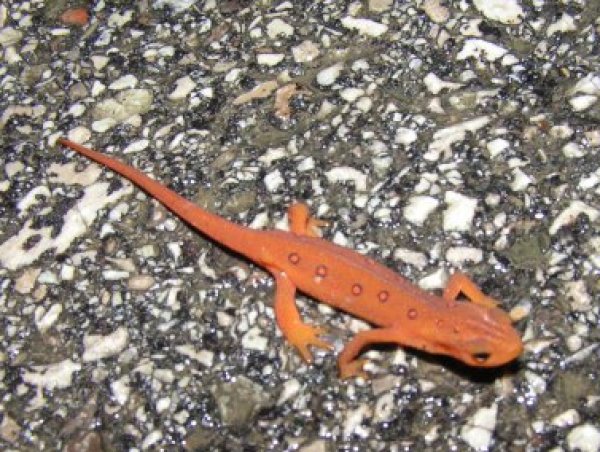 |
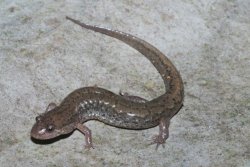 |
Northern Dusky Salamander
Desmognathus f. fuscus
Size: 2 ½ – 4 inches
Species Status: Common
Similar Species: Redback salamander (smaller and more slender)
more >> |
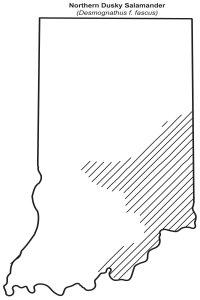 |
Northern Dusky Salamander
Desmognathus f. fuscus
Size: 2 ½ – 4 inches
Species Status: Common
Range: The unglaciated region of southeastern Indiana and along the Ohio
boarder counties.
Description: A stout bodied light or dark brown to grayish salamander.
Head is oval and wider in males. 13-14 costal grooves are present. Limbs are
short and stocky. Tail is roughly triangular in cross section. A light or white
line runs from the eye downward to the jaw opening. General pattern is variable
and breaks up as the animal ages. Young appear lighter in color and have a
stronger pattern.
Habitat: Rocky upland hills of seepages, springs, and rocky creeks. Can be
found in small rocky creeks under stones. May also be found near the mouths of
caves but not in them.
Habits: Inhabits wet, rocky, spring-fed hill sides where it clings to wet
stones under cover. They are incredibly fast and slippery. Almost always found
in or near flowing water.
Diet: Earthworms, snails, and other invertebrates.
Reproduction: Mating occurs summer and 13- 24 eggs hatch in fall. Male
performs courtship displays for female and drops a spermatophore. The female they
picks up the sperm pouch and eggs are fertilized. Female will then deposit eggs,
curl around and guard them until they hatch.
Similar Species: Redback salamander (smaller and more slender)
<< less
|
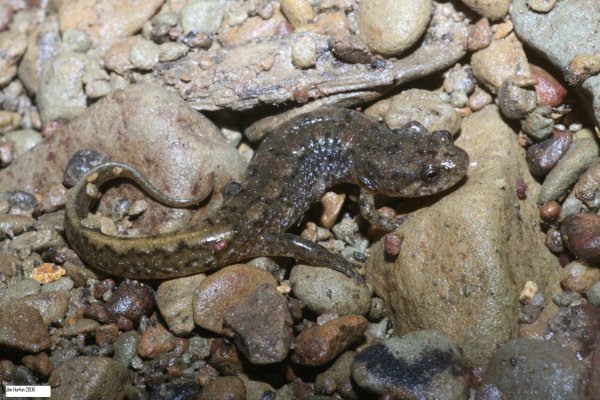 |
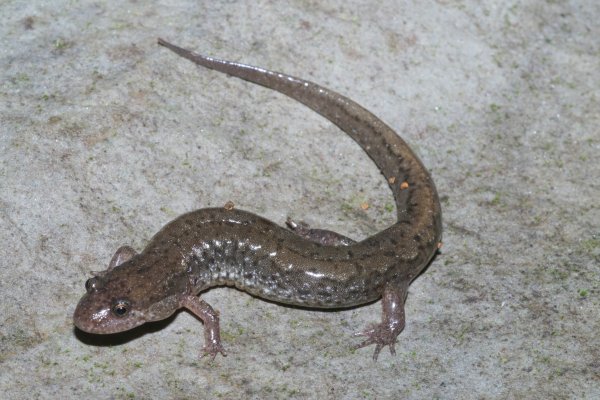 |
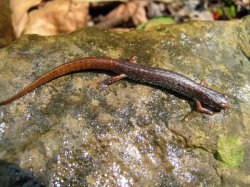 |
Four-toed Salamander
Hemidactylium scutatum
Size: 2 - 3 ½ inches
Species Status: Common
Similar Species: Redback salamander (lacks white speckled belly)
more >> |
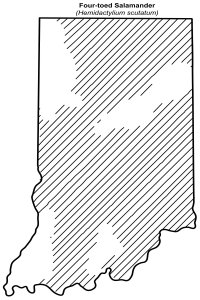 |
Four-toed Salamander
Hemidactylium scutatum
Size: 2 - 3 ½ inches
Species Status: Common
Range: Scattered fragmented distribution throughout the state.
Description: Our smallest salamander with four toes on each hind feet. The
key feature on this species is the belly which is white with stark black dots.
12-14 costal grooves along sides. Slender body with tan or brown coloration
mottled with bronze flecks. Tail is round to oval and constricted at the base.
Habitat: Flat, forested uplands or low lying forest habitat with temporary
or permanent wetlands or ponds. Swamps, bogs, or temporary ponds with sphagnum
moss.
Habits: Inhabits moist woodlands with spaghnum moss at edges. Found under
most, rotting logs, leaf litter, and moss.
Diet: Insects and other small arthropods.
Reproduction: Mating occurs in spring. Rainfall triggers breeding
activity. Mating takes place on land near woodland ponds. Females lay 15-20
round white eggs. Females take cover under fallen logs and moss. She stays
curled with eggs at the water edge. Females await heavy rainfall that washes
eggs into the water and young soon develop.
Similar Species: Redback salamander (lacks white speckled belly)
<< less
|
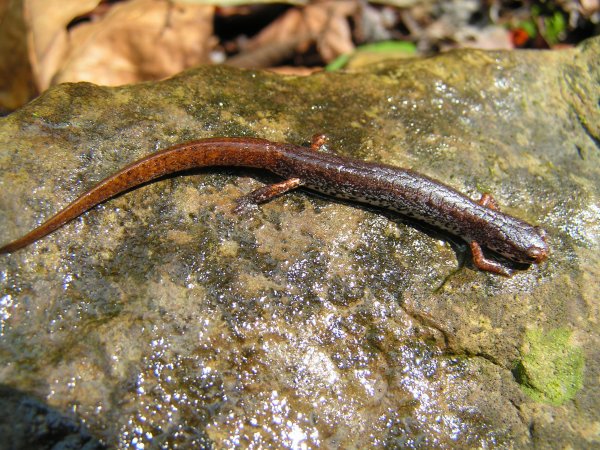 |
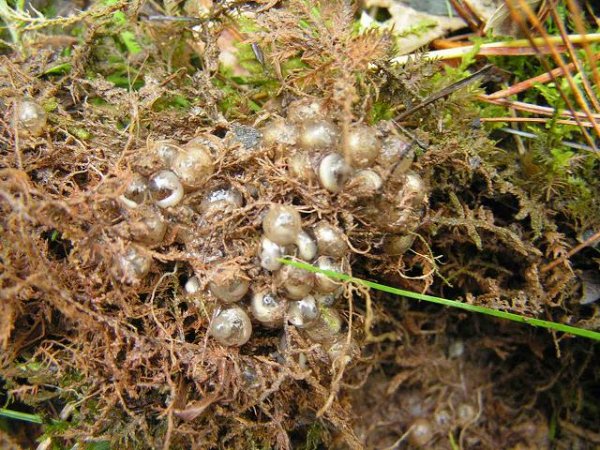 |
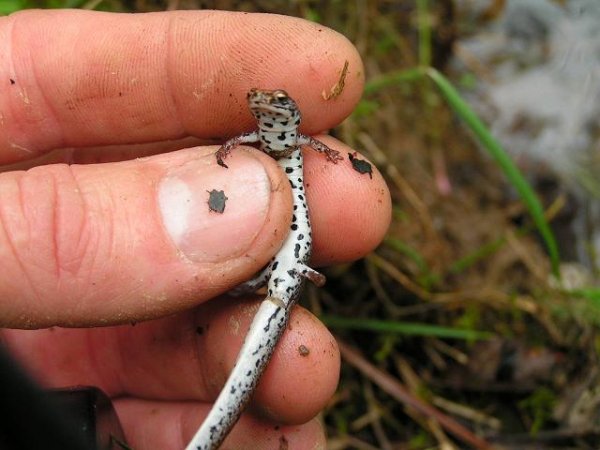 |
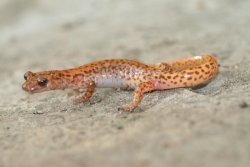 |
Cave Salamander
Eurycea lucifuga
Size: 4 – 6 inches
Species Status: Somewhat common in its range
Similar Species: Longtail salamander (has vertical bars on tail)
more >> |
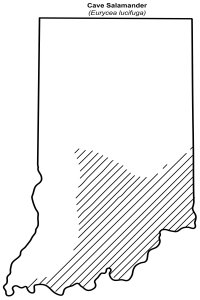 |
Cave Salamander
Eurycea lucifuga
Size: 4 – 6 inches
Species Status: Somewhat common in its range
Range: Cave salamanders are restricted to the southeast and extend
northwest up through the south-central part of the state.
Description: A medium slender orange salamander with black spots. Head is
flatter and wider than longtail salamanders. Body is more flattened with 12-14
costal grooves. Typically orange or reddish with scattered black spots from
head to tail. Limbs are long and spotted. Belly is cream to white. Iris is
bronze. Larvae are grayish brown with four limbs, external gills, and two rows
of light spots. May be confused with the longtail salamander.
Habitat: In and around cave entrances. Near seepages or spring fed
sources. Others have been reported in crevices of large rock bluffs.
Habits: Agile climbers, their flat body enables them to take refuge in
crevices. They are often found at the mouths of caves. Also may be found under
rocks, logs, and other suitable cover.
Diet: Arthropods and invertebrates.
Reproduction: Mating occurs in summer to autumn. Females lay 60-100 round,
white eggs (not in a jelly like mass) singly on the underside of logs and rocks
in underground springs or caves. Eggs may hatch in late autumn or winter.
Larval stage lasts 6-18 months.
Similar Species: Longtail salamander (has vertical bars on tail)
<< less
|
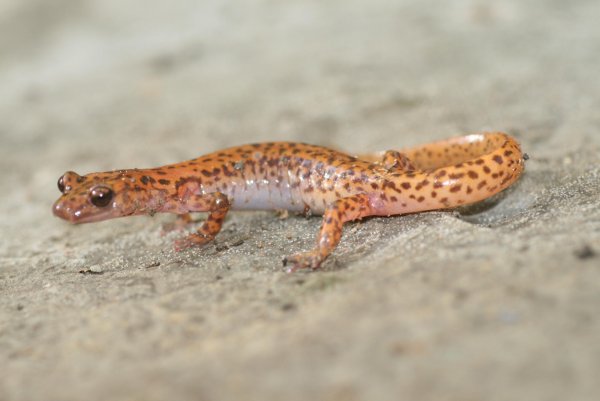 |
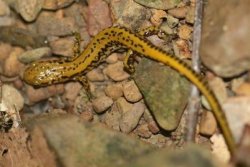 |
Longtail Salamander
Eurcyea l. longicauda
Size: 4 – 6 inches
Species Status: Common in its range
Similar Species: Cave salamander (no vertical bars on tail)
more >> |
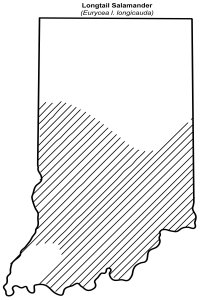 |
Longtail Salamander
Eurcyea l. longicauda
Size: 4 – 6 inches
Species Status: Common in its range
Range: Common in southeastern and south central Indiana. Ranges up to the
west in Park and Montgomery counties but is extremely rare in the southwestern
Wabash valley lowlands.
Description: A medium slender yellow to orange salamander with black spots
or mottling. Limbs are long and mottled or lightly speckled. 13 - 14 costal
grooves on sides. Black mottling occurs throughout body but more concentrated on
sides. Tail is compressed vertically and has uniform vertical black bars to the
tip. Belly is light. Larvae are slim, dark, 4 limbs, and short external gills.
May be confused with the cave salamander.
Habitat: Rocky, clean brooks (similar to that of the two-lined salamander).
Preferred habitat has cool, shaded water associated with seepages and springs.
Habits: Commonly found beneath logs or rocks. Some may be found a
considerable distance from water. They are quick to escape when uncovered.
Typically active from April to October.
Diet: Arthropods and invertebrates.
Reproduction: Mating occurs in autumn (unlike most of our other
salamanders) Mating takes place on land near streams. Females lay 60-100 round,
white eggs (not in a jelly like mass) singly on the underside of logs and rocks.
Eggs hatch in late autumn soon develop into larvae.
Similar Species: Cave salamander (no vertical bars on tail)
<< less
|
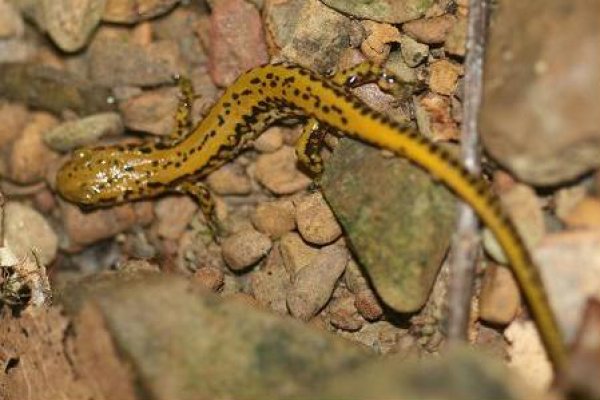 |
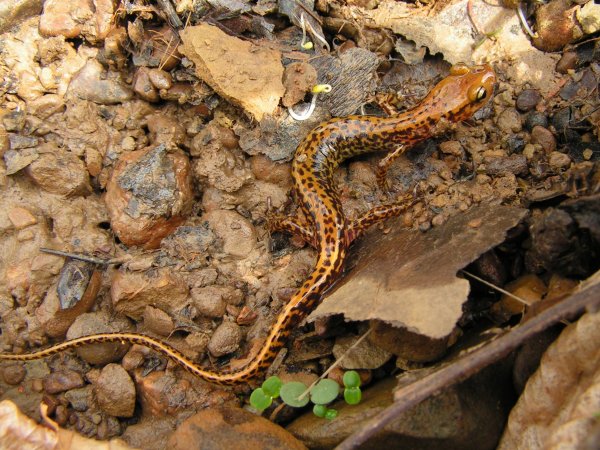 |
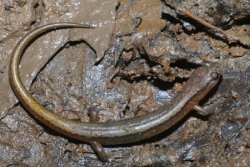 |
Southern Two-lined Salamander
Eurycea cirrigera
Size: 2 ½ – 3 ¼ inches
Species Status: Common
Similar Species: Redback salamander (lacks dorsal lines)
more >> |
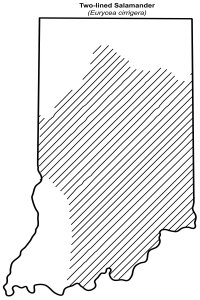 |
Southern Two-lined Salamander
Eurycea cirrigera
Size: 2 ½ – 3 ¼ inches
Species Status: Common
Range: Plentiful in central and southern Indiana east of the Wabash lowlands.
Description: Bronze, yellowish salamander with a slender body. Dark stripe
runs along each side of body from the eye to the tail. Dorsally, between the two
stripes may have dark specking running down center. Below side stripes may be
pale or speckled. Belly is yellowish and may be almost translucent. Larvae are
dark with two rows of light spots dorsally, 4 limbs, and short external gills.
Habitat: A brook side species lying under cover of flat rocks at the edge
of water. Small, clean flowing stream is preferred habitat.
Habits: Inhabits moist woodlands with loose soil. Found in or beneath large
stones, logs, or clumps of wet leaves. Active through summer, fall, and
occasionally, winter.
Diet: Feed on a variety of aquatic and terrestrial invertebrates.
Reproduction: Breeding takes place on land in spring. Female will deposit
20-200 eggs on the underside of large flat stones at the edge of a stream. Young
are tiny, aquatic, and have feathery gills.
Similar Species: Redback salamander (lacks dorsal lines)
<< less
|
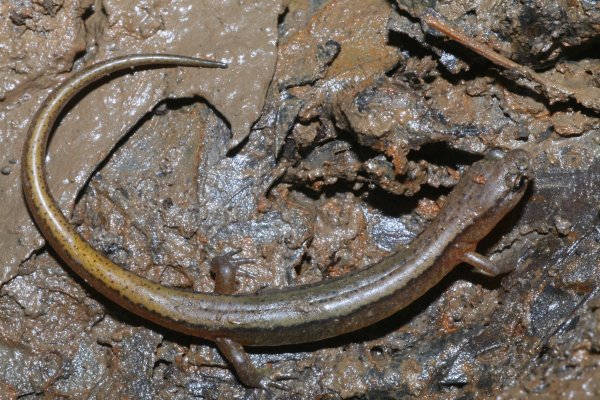 |
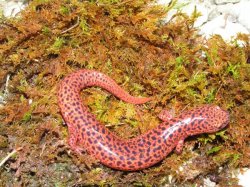 |
Northern Red Salamander
Pseudotriton ruber
Size: 4 – 5 ½ inches
Species Status: Endangered
Similar Species: Cave salamander (longer, flat, slim body)
more >> |
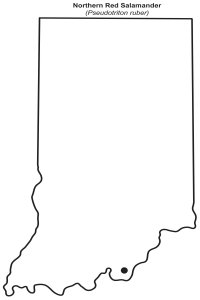 |
Northern Red Salamander
Pseudotriton ruber
Size: 4 – 5 ½ inches
Species Status: Endangered
Range: Restricted to the lowlands of Floyd County. Has not been documented
in decades but suitable habitat is present.
Description: A stout bodied chubby salamander with rounded head and short,
thick tail. Body is red to dark orange background with black spots throughout.
Short limbs are speckled and tail is thick and laterally flattened toward the
tip. 16-17 costal grooves present on sides. Iris is gold. Belly is pinkish-white
with some speckling. Young are brightly colored and become darker as they mature.
Habitat: Forested hills with seepages, springs, and small muddy creeks.
Prefers cool, small spring-fed creeks.
Habits: Inhabits moist woodlands. Found in or beneath rotting logs, stones,
or leaf litter.
Diet: Earthworms and other invertebrates.
Reproduction: Mating occurs from spring through fall. Females lay eggs in
small spring or streams attached to submerged rocks. The aquatic larval stage may
last two to three years.
Similar Species: Cave salamander (longer, flat, slim body)
<< less
|
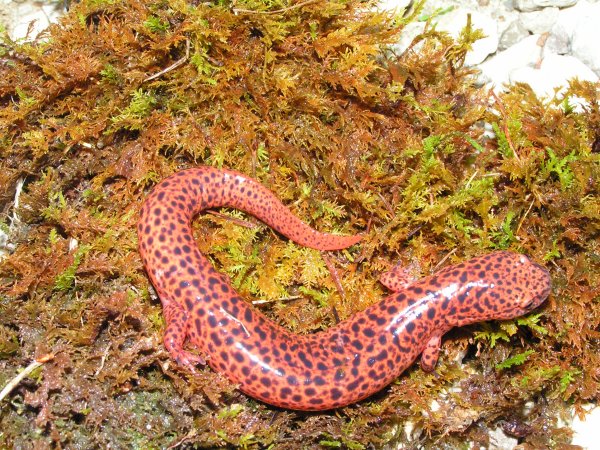 |
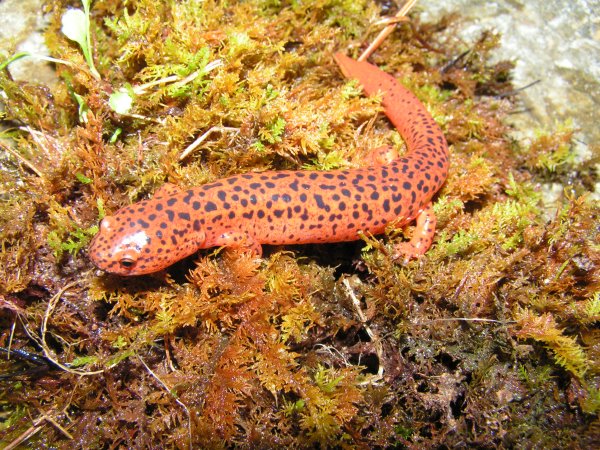 |
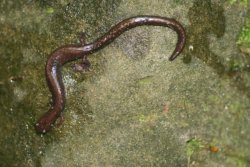 |
Ravine Salamander
Plethodon richmondi
Size: Size: 3 – 4 ½ inches
Species Status: Common
Similar Species: Redback and Zigzag salamanders.
more >> |
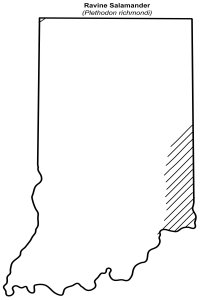 |
Ravine Salamander
Plethodon richmondi
Size: Size: 3 – 4 ½ inches
Species Status: Common
Range: Found in Southeast Indiana from Jefferson to Wayne counties.
Description: Small, slender, short legged salamander. 20-21 costal grooves
present along sides. Sides and limbs are dark gray with light speckling. Ground
color is uniformly dark gray to brown with no stripes. Ventral is dark grey with
light speckling. Tail is darker and longer tail than the redback.
Habitat: Inhabits moist rocky woodland slopes, valleys, and ravines.
Habits: Commonly found under fallen wood, stones, or other suitable cover.
One of our most common salamanders. May be active throughout the winter months.
Diet: Invertebrates.
Reproduction: Breeding takes place in late fall to early spring. Female
lays 3-14 eggs in spring. Eggs are laid on land in a rotting log. Female guards
eggs invertebrates and other salamanders. Young will emerge as tiny adults (there
is no larval stage).
Similar Species: Redback and Zigzag salamanders.
<< less
|
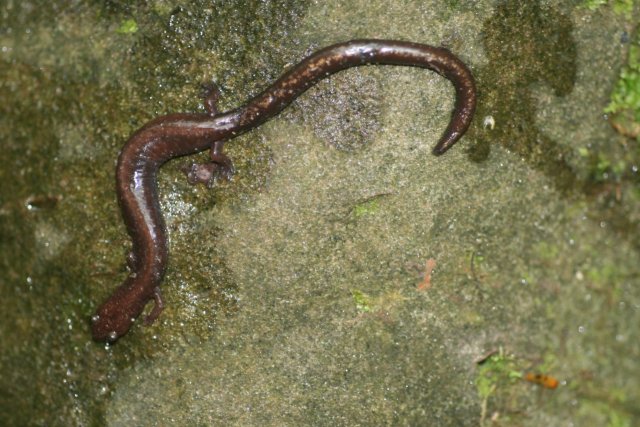 |
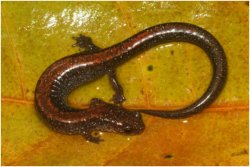 |
Redback Salamander
Plethodon cinerieus
Size: 2 ½ – 4 inches
Species Status: Common
Similar Species: Ravine and Zigzag salamander.
more >> |
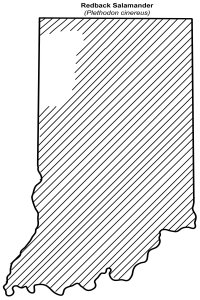 |
Redback Salamander
Plethodon cinerieus
Size: 2 ½ – 4 inches
Species Status: Common
Range: Found in most of Indiana but absent from Kankakee prairie region.
Description: Small, slender, short legged salamander. 18-19 costal grooves
present along sides. Two color morphs. One has a wide reddish, orange, or tan
stripe along the back to base of tail. Sides and limbs are dark gray with light
speckling. The other (leadback phase) is uniformly dark gray with no stripes.
Ventral is dark grey with light speckling. An all red color variation may occur
occasionally.
Habitat: Inhabits moist woodland areas with undisturbed ground cover.
Habits: Commonly found under fallen wood, stones, or other suitable cover.
One of our most common salamanders. May be active throughout the winter months.
Diet: Invertebrates.
Reproduction: Breeding takes place in late fall to early spring. Female
lays eggs in spring. Eggs are laid on land in a rotting log. Young will emerge as
tiny adults (there is no larval stage).
Similar Species: Ravine and Zigzag salamander.
<< less
|
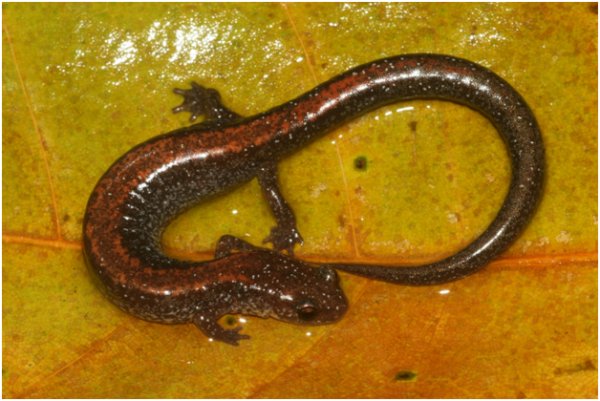 |
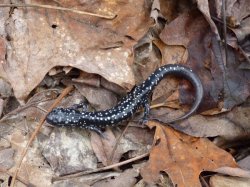 |
Northern Slimy Salamander
Plethodon glutinosus
Size: 5 – 7 inches
Species Status: Common
Similar Species: Blue-spotted salamander.
more >> |
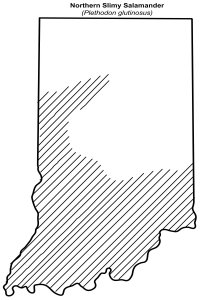 |
Northern Slimy Salamander
Plethodon glutinosus
Size: 5 – 7 inches
Species Status: Common
Range: Found in most of lower Indiana and extends up to the northwest
Wabash valley.
Description: Medium size salamander with black background and white
speckling. 15 costal grooves present on sides. Sides may be mottled with white.
Belly is grayish black or lighter. Tail is round and usually grey.
Habitat: Inhabits hilly, rocky woodland areas and ravines. An agile
burrower finding refuge in rotted logs and leaf litter.
Habits: A fossorial species that burrows in loose soil and leaf litter.
Found in or beneath rotting logs or stones. Will quickly go for cover or shoot
down a hole when alarmed. Will secrete a white, sticky, gluey substance on the
tail when disturbed.
Diet: Earthworms and other invertebrates.
Reproduction: Breeding takes place in fall and female lays eggs in spring.
Eggs are laid on land in a rotting log. Young will emerge as tiny adults (there
is no larval stage).
Similar Species: Blue-spotted salamander.
<< less
|
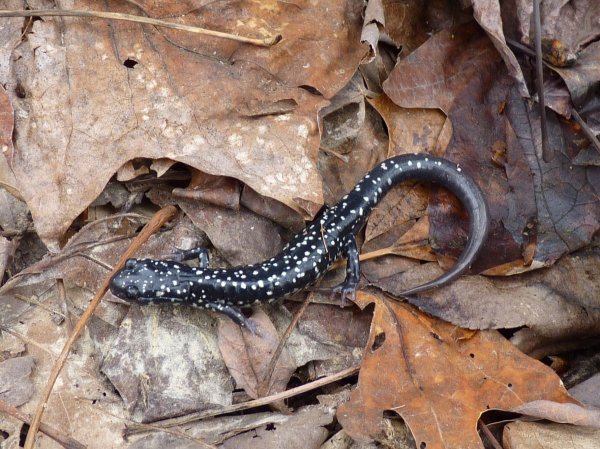 |
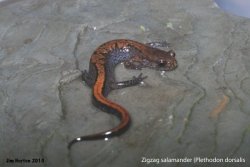 |
Zigzag Salamander
Plethodon d. dorsalis
Size: 2 ½ – 4 inches
Species Status: Common
Similar Species: Ravine and Redback salamanders.
more >> |
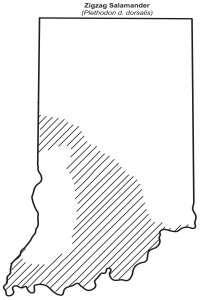 |
Zigzag Salamander
Plethodon d. dorsalis
Size: 2 ½ – 4 inches
Species Status: Common
Range: Found in most of Indiana but absent from Kankakee prairie region.
Description: Small, slender, short legged salamander. 15-17 costal grooves
present along sides. Two color morphs. One has a wide reddish, orange, or tan
zigzag stripe along the back to base of tail. Sides and limbs are dark gray with
light speckling. The other (leadback phase) is uniformly dark gray with no
stripes. Ventral is dark grey with light speckling. An all red color variation
may occur occasionally.
Habitat: Inhabits moist woodland areas with undisturbed ground cover.
Habits: Commonly found under fallen wood, stones, or other suitable cover.
One of our most common salamanders. May be active throughout the winter months.
Diet: Invertebrates.
Reproduction: Breeding takes place in late fall to early spring. Female
lays eggs in spring. Eggs are laid on land in a rotting log. Young will emerge as
tiny adults (there is no larval stage).
Similar Species: Ravine and Redback salamanders.
<< less
|
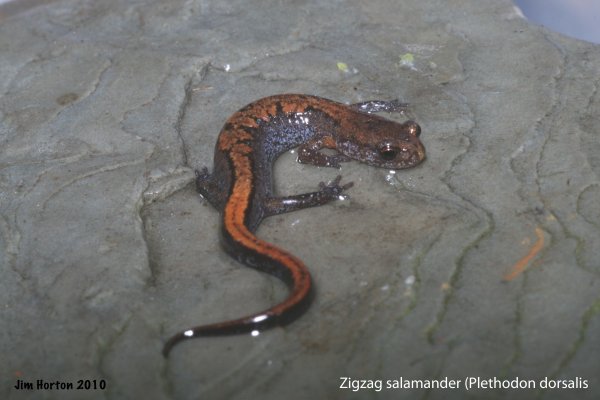 |
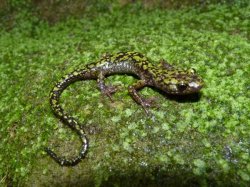 |
Green Salamander
Aneides aeneus
Size: 3¼ – 5 inches
Species Status: Endangered
Similar Species: None
more >> |
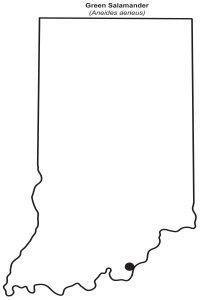 |
Green Salamander
Aneides aeneus
Size: 3¼ – 5 inches
Species Status: Endangered
Range: Found only in Crawford County.
Description: A slender, long-legged salamander with green lichen-like
markings on a dark ground color. Head is flat and distinct from neck. Body is
flat shaped and 14-15 costal grooves present. Limbs are long with green and
black speckling. Toes are long with squared tips. Tail is round and mottled with
green and black. Belly is light colored and unmarked.
Habitat: Inhabits wooded rock outcrops with deep crevices.
Habits: Inhabits rocky sandstone cliffs and outcrops. Deep crevices
slightly damp but not wet are preferred conditions. This species is occasionally
arboreal and an agile climber and jumper. Flat head and body enable it to enter
tight crevices.
Diet: Invertebrates.
Reproduction: Breeding takes place May through June. Female deposits 10-25
eggs to the roof or sides of rock crevices. Female guards eggs until they hatch.
Young will emerge as tiny adults (there is no larval stage).
Similar Species: None
<< less
|
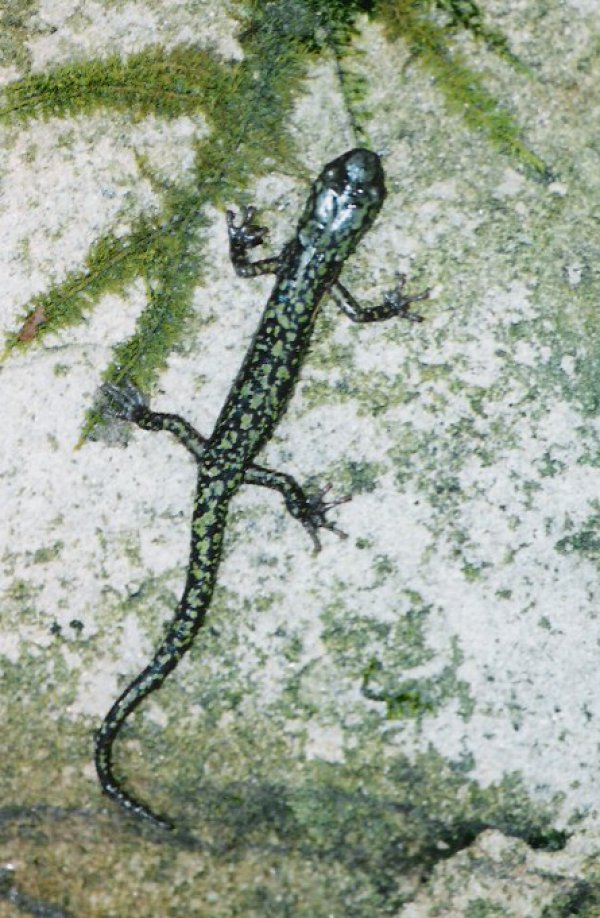 |
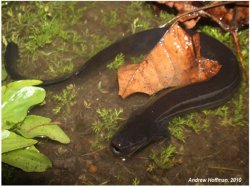 |
Western Lesser Siren
Siren intermedia nettingi
Size: 7 – 27 inches
Species Status: Uncommon
Similar Species: None
more >> |
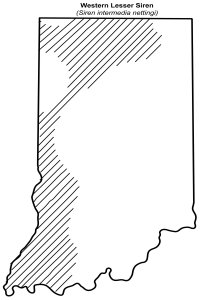 |
Western Lesser Siren
Siren intermedia nettingi
Size: 7 – 27 inches
Species Status: Uncommon
Range: From Wabash and Kankakee drainage to lowlands of southwestern
Indiana.
Description: An eel-like aquatic salamander with tiny front limbs and
external gills. A slender, long body with 32-37 costal grooves along sides. Head
is narrow. Adults typically have a light stripe on upper lip. Ground color is
uniformly brown, olive green, to dark gray with no stripes. Front legs have four
digits. Belly is slightly lighter then the dorsum.
Habitat: Inhabits warm shallow swamps, ponds, ditches, or inlets of lakes
with mucky bottoms and aquatic vegetation.
Habits: Sirens will aestivate underground during hot, dry weather forming
a cocoon of mucus for temporary protection until rains arrive. This aquatic
species is also known to emit clicks and yelping sounds. Clicking is most
likely a form of communication while others are associated with distress.
Diet: A variety of aquatic insects, crawfish, and earthworms.
Reproduction: Breeding occurrs in spring. 200 to 700 eggs are laid in nests
at the bottom of ponds. The larval stage may last two to three years.
Similar Species: None
<< less
|
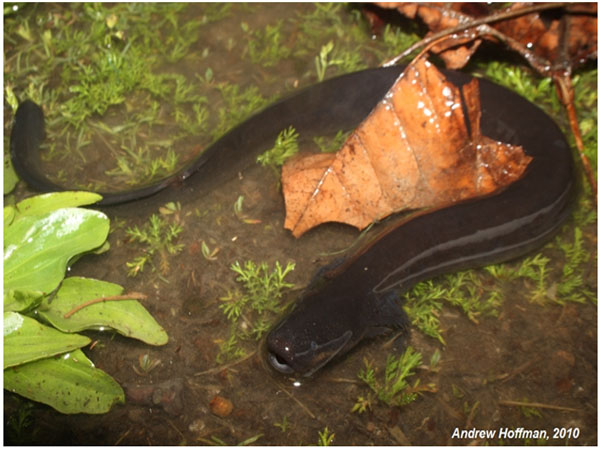 |
|















































































